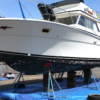
Rafting up has long been a favorite boating activity, and for a good reason. It’s just great fun! So, if tying up to other boats to create a good time flotilla sounds like something you want to try, let the crew at Snag-A-Slip share the techniques and unwritten rules of rafting up.
Yes, there are actual raft-up dos and don’ts, some for safety and others just for proper boating etiquette. We always want to show respect for other boaters’ boats and make sure everyone is safe. Although rafting up is a fairly simple event, there is some finessing involved. And you don’t want to ruin your, or anyone else’s, good time by making a raft-up faux pas. Here are a few tips to assure that your raft-up experience is not only a memorable one but a safe one too.
Raft up etiquette and best practices
Rafting up with other boaters is an absolutely social affair. Since that’s the case, here are a few common raft-up courtesies you can easily show your fellow boaters:
- – Depending on the size of the raft up you’ll be joining, you may not know your immediate neighbor. If that’s the case, always ask permission first, before coming alongside.
- – Once rafted up, turn your engine(s) and generator off. They can be noisy and smelly, especially when a few boats are together. Not to mention, the sound can drown out conversation or be simply annoying.
- – Arrive at the raft-up with your batteries fully charged.
- – Don’t drown out the good time with a stereo that’s too loud. Always consider others.
- – Be sure to use appropriate language, especially when families with kids are rafted up.
And as with any boating activity, make sure the captain is sober at all times. As tempting as it is to partake in the partying if you’re going to be operating the boat at any time, save your cocktail for when you’re safely back in your slip.
How to properly Raft-up
If you’ve never rafted up before, you’re probably thinking it looks pretty simple – boats tie up to one another, and everyone has fun! You’re mostly right. However, for the raft up to be successful for everyone, there are a few basic logistical rules you’ll want to follow. Many may be common sense, but each is an important piece of the puzzle:
- The largest and heaviest boat should be the anchor boat – literally. The largest boat should drop its anchor first. Once anchored, it will be the building block for the other boats to tie up along either side.
- Slow it down when approaching and joining a raft-up. You don’t want to rock the boats and cause any potentially damaging collisions.
- Try and raft together with boats that are a similar size to yours.
- It’s key for boats to alternate sides of the anchor boat as they join the raft up. You don’t want to have far more boats on one side than the other. The raft-up will swing the least amount with the anchor boat in the middle of the raft of boats.
- Before approaching another boat, deploy your fenders.
- Position your boat so that your swim platform is aligned with those of the other boats in the raft up.
- Secure your boat to other boats using the cleats. Don’t make the mistake of tying up using handrails, rail stations or any other convenient accessories.
- To minimize motion between boats, keep the lines tied as tight as possible.
How to properly tie up to another boat in the raft-up
If you don’t have much, or any, experience tying up to another boat, here is what you’ll need to do:
- – First, deploy your fenders before approaching another boat to raft up to.
- – Too many fenders are better than not enough. But the rule of thumb is at least one fender for every 10 feet of boat length overall (LOA).
When your fenders are in place, you’ll want to tie the bows and sterns of the boats together. Also, run lines from the bow of one boat to the stern of the other. This will minimize fore and aft motion.
Raft-up safety tips
Safety is always topmost when you’re on the water. It’s especially important when you’re rafting up because multiple boats are involved. There are some unique safety issues to consider above and beyond the close proximity between rafted boats bringing with it the potential for dings and scrapes to your beloved seafaring possession. Here’s what you can do to stay safe when rafting up, or just cruising past:
- – Take it slow when approaching or joining a raft-up – we’re talking idle speed. The fact is that large wakes are a big problem in these situations. So, always minimize your wake.
- – Don’t ever cut between a raft of boats and the beach. Most likely, passengers will be swimming back and forth in the area. For that same reason, always pass a raft of boats on their bow side – never pass on their stern sider where people may be in the water.
- – All hands and feet in the boat while rafting up. You don’t want anyone onboard to get pinched. Also, remind them not to put their hands and feet between the boats once tied together.
- – Since you should be tied to your neighbors’ boats so your swim platforms are aligned, if someone wants to go from boat to boat, they should walk along with the platforms instead of trying to climb from boat to boat.
For many of us, boating is enjoyed with a limited number of family and/or friends. Rafting up lets you grow your nautical social circle. Plus, it’s more fun to socialize while rafted up on the water than it is at any boring old party on land.








